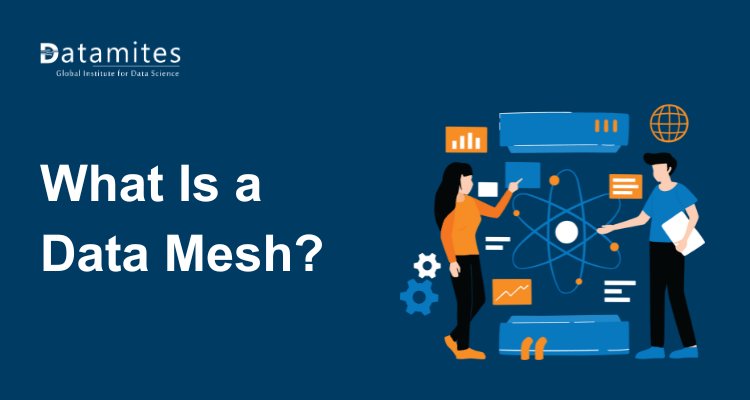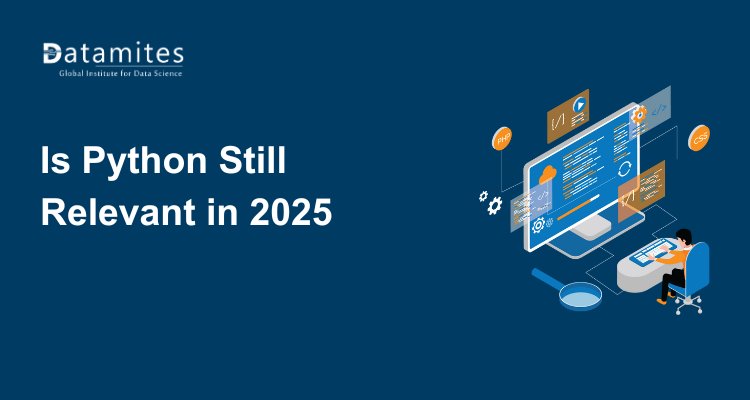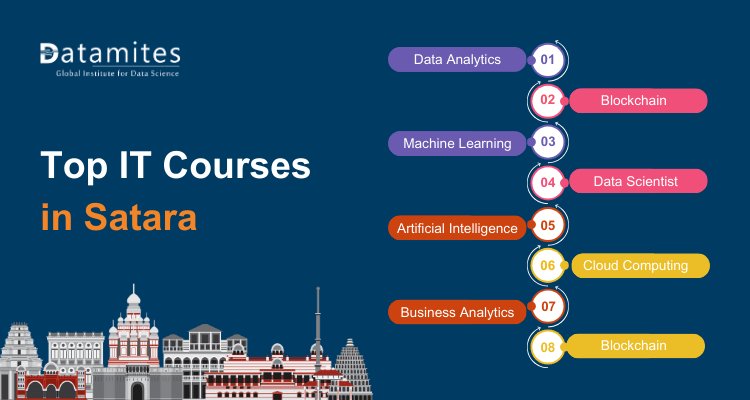What Is a Data Mesh? Principles, Benefits, and Examples
A data mesh is a modern decentralized approach to data architecture that treats data as a product and assigns ownership to domain teams. It enhances scalability, data accessibility, and collaboration across large organizations through self-serve data infrastructure.

Data has become the driving force behind every modern business decision. From e-commerce and healthcare to banking and manufacturing, companies rely heavily on analytics and Data Science to stay competitive. However, as organizations grow, so does the amount of data they generate and managing it centrally has become a massive challenge. Traditional data systems often struggle to scale, leading to bottlenecks, delays, and inconsistent insights across departments.
That’s where Data Mesh comes in. This modern approach to data management is transforming how organizations collect, store, and use data. Instead of depending on a single, centralized data team, Data Mesh empowers individual teams to own, manage, and share their data as a product enabling faster, scalable, and more reliable analytics.
What Is a Data Mesh and Why Is It Important?
A Data Mesh is a modern, decentralized approach to managing data across an organization. Instead of depending on a single central data team, it allows each department such as marketing, sales, or finance, to take ownership of its own data.
Each team treats data as a product, ensuring it is accurate, accessible, and valuable for others to use. This approach replaces traditional centralized systems with a more collaborative and scalable data architecture that enhances efficiency and accountability.
The importance of Data Mesh is growing rapidly across industries. According to Data Bridge Market Research, the global Data Mesh market size was valued at USD 1.46 billion in 2024 and is expected to reach USD 5.09 billion by 2032, growing at a CAGR of 16.90% during the forecast period. This surge reflects how organizations are increasingly adopting Data Mesh to overcome data bottlenecks, speed up insights, and empower teams to drive better, data-informed decisions.
Why Data Mesh Matters in Modern Data Science
In today’s data-driven organizations, the speed and quality of insights can determine success. Traditional systems like data lakes and warehouses often struggle to keep up with growing data volumes and diverse business needs. They rely on centralized teams that become bottlenecks, slowing down access to critical information.
Data Mesh solves this problem by decentralizing data ownership. It allows individual teams to manage and share their data independently, ensuring faster access, better accuracy, and more flexibility. This structure empowers data scientists and analysts to work directly with reliable data without waiting for approvals or technical dependencies.
As a result, Data Mesh in Data Science enables organizations to scale their analytics efforts efficiently, foster collaboration, and unlock quicker, more meaningful insights across all departments.
Refer to these articles:
- A Beginner’s Guide to the Standard Normal Distribution
- The Ultimate Guide to Data Science Models
- Understanding Autocorrelation Function in Data Science
Core Principles of Data Mesh
At the heart of Data Mesh are four guiding principles that define how data should be managed and shared across an organization.
1. Domain Ownership
Data Mesh emphasizes domain-driven design meaning each business unit (like marketing, sales, or finance) owns and manages its own data. This promotes accountability, as the people closest to the data ensure its accuracy and relevance.
2. Data as a Product
In a Data Mesh, data isn’t just a by-product of business operations it’s treated as a product. Teams are encouraged to make their data easy to discover, understand, and use. This mindset improves data quality, documentation, and usability across departments.
3. Self-Serve Data Platform
A self-serve data platform provides the necessary data science tools, infrastructure, and technologies to help teams manage and share their data without relying on a central IT department. This platform standardizes how data is stored, accessed, and secured, making the process smoother for everyone.
4. Federated Governance
While decentralization promotes independence, federated governance ensures consistency and compliance across the organization. It sets shared policies for data privacy, quality, and access balancing freedom with control.
Together, these Data Mesh principles create a robust foundation for a scalable, business-friendly modern data architecture that supports both collaboration and innovation.
Benefits of Implementing a Data Mesh
Organizations that adopt a Data Mesh architecture often experience a wide range of business and technical benefits. Here are some of the most impactful ones:
1. Scalability Across Departments
Since each team manages its own data, scaling becomes easier. As more departments generate and share data, the overall system grows organically without overwhelming a single central team.
2. Faster Data Access and Insights
With decentralized ownership, teams don’t have to wait for approvals or resources from a central data team. They can access and use data instantly, leading to faster analysis and decision-making.
3. Better Collaboration Between Teams
Data Mesh fosters a culture of collaboration, where departments freely share and consume each other’s data products. This transparency drives better alignment between business goals and analytics.
4. Enhanced Data Quality and Accountability
When teams own their data, they take responsibility for maintaining its accuracy and usability. This ownership model results in more reliable and trustworthy datasets across the company.
5. Reduced Bottlenecks and Maintenance Costs
Centralized systems often face slowdowns due to heavy data loads and limited resources. A Data Mesh distributes this load, minimizing delays and reducing the need for constant central maintenance.
In short, the benefits of Data Mesh extend beyond technology they improve how organizations operate, collaborate, and innovate.
Refer to these articles:
- Bias-Variance Tradeoff: Key Concept in Data Science Models
- Cross Entropy in Data Science: Concepts and Applications
- Box Plot in Data Science: How to Visualize Data Spread
Real-World Examples and Use Cases of Data Mesh
Several global organizations have started implementing Data Mesh to handle their ever-growing data ecosystems.
- Netflix: As a data-driven company, Netflix uses decentralized data systems to manage massive volumes of user and viewing data. Each business domain from recommendations to marketing owns its data products, ensuring faster insights and experimentation.
- Zalando: The European fashion retailer adopted a Data Mesh architecture to overcome scaling issues in its centralized data platform. By empowering domain teams, Zalando improved data quality, accessibility, and overall productivity.
- Shopify: Shopify has embraced Data Mesh principles to enhance its analytics capabilities across different business units, allowing teams to build and maintain their own data pipelines.
These Data Mesh examples show how decentralization can drive efficiency, collaboration, and innovation making it one of the most promising modern data architectures for large organizations.
Challenges in Implementing Data Mesh
While the concept sounds ideal, Data Mesh implementation challenges are real. Organizations often face hurdles like:
- Cultural Resistance: Shifting from a centralized to decentralized model requires a major cultural change. Teams must adopt new responsibilities and learn to collaborate differently.
- Governance Complexity: Balancing autonomy with standardized governance can be tricky. Without proper policies, data consistency and compliance may suffer.
- Skill Gaps: Teams need the right data science skills and tools to manage data independently. This may require additional training or hiring.
Despite these challenges, with the right leadership and structure, organizations can gradually transition to a Data Mesh model that aligns with their long-term data goals.
As data continues to grow in volume and complexity, traditional centralized systems are reaching their limits. Data Mesh offers a revolutionary way to rethink how businesses manage and use data empowering teams, improving data quality, and enhancing scalability.
For professionals looking to build a career in Data Science, understanding Data Mesh architecture and its principles can provide a valuable edge. Learning how decentralized data systems work will help you adapt to the future of Data Science, where collaboration and data ownership define success.
Refer to these articles:
If you’re ready to explore the evolving world of Data Science and master modern data management techniques, enrolling in a comprehensive training program can be the perfect next step.
Kickstart your Data Science career today and gain the in-demand skills employers are actively looking for. By joining data science training in Pune, Coimbatore, Hyderabad, Ahmedabad, Bangalore, Chennai, or Mumbai, you’ll develop practical knowledge, work on real-world projects, and receive expert career guidance that prepares you to enter this fast-growing field with confidence. As the demand for skilled data professionals continues to surge, the right training can open doors to diverse and rewarding career opportunities.
Among the leading institutes, DataMites Institute stands out for its industry-driven curriculum and focus on hands-on learning. With live projects, internships, and dedicated placement support, DataMites helps students bridge the gap between theory and practice, ensuring they’re ready for real-world challenges.
The Certified Data Scientist course at DataMites Institute accredited by IABAC and NASSCOM FutureSkills covers essential tools, machine learning workflows, and advanced analytics techniques valued across sectors like finance, healthcare, and beyond. Learners who prefer classroom sessions can join DataMites data science courses in Hyderabad, Mumbai, Delhi, Pune, Chennai, Bangalore, Ahmedabad, or Coimbatore. Those who value flexibility can opt for DataMites’ online courses, offering the same high-quality training accessible from anywhere.





